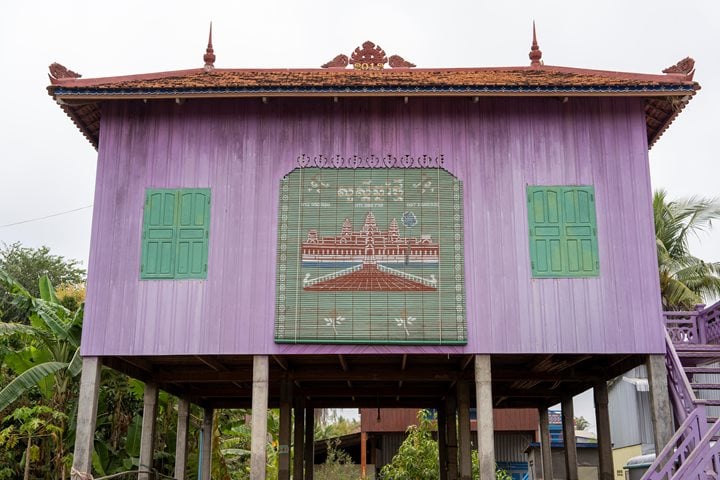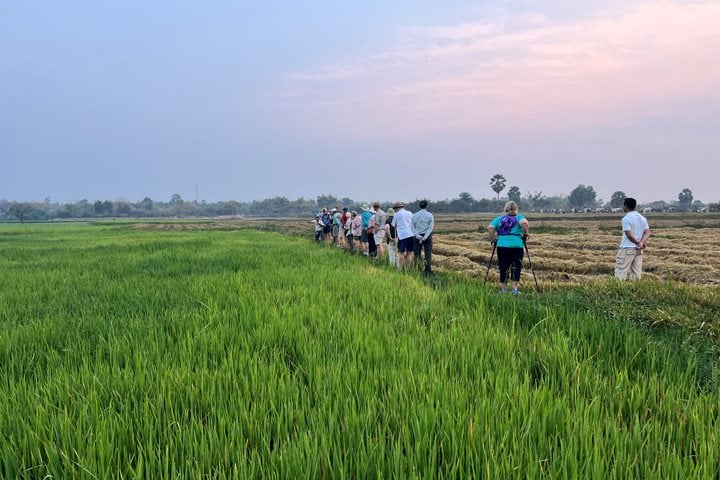Cai Be, Mekong River Delta, Vietnam
Hats off to those of us aboard the Jahan who were disciplined enough to start their day with a Tai chi session at the crack of dawn. After breakfast, we mingled around getting to know others on the ship, checking out the books in the library, or spending a few moments connecting with home via email and the internet. By 9am, home and the outside world were forgotten with the first boat ride of the day.
We rode on two motorboats, 25 aboard each, to discover the Mekong and its small canals, gliding among the ever-present water hyacinths—serving both as a way to stop soil erosion, and a trap that attract fish for the ready fishermen. A while later we found ourselves in the town of Cai Be, amidst one of the many floating markets in the delta.
You could begin to understand the gregarious and outgoing nature of the local people: there were plenty of (water)ways for them to travel from their small villages or their small islands outward, to meet others, learn new things. “The big boats are like a home,” one of our guides had explained. “The small boat is like a car.”
The small boats brought stacks and stacks of fruits and vegetables—mango, watermelon, tapioca, longan—and offer them to the big boats that are moored and ready to sell the harvests. One looks to the top of a pole pointing skyward. Whatever is on the pole, that’s the fruit offered by that boat.
Other small boats carried bags of the fruits to the markets on land. There were also boats that carried fish in big bags half-filled with water and oxygen, destined via land routes to Ho Chi Minh City, to markets and restaurants.
Perhaps it was because Lunar New Year was just a mere ten days ago—many of the boats had large pots of bright pink bougainvilleas next to pots of yellow apricots. They stood out on the decks of the boats—which cost about 2,000 US dollars to buy, we were told. It’s amazing how people live so calmly on such boats, their living quarters cramped; their kitchen a mere counter. These are resourceful people with no sofas or big fridges or washing machines. They seem content enough to rock back and forth in a hammock hanging inside a few square meters, and perhaps enjoy a breeze blowing through the cabins. Outside, they are surrounded by the ever-present coconuts, water apples, pineapples and jack fruits and sacks of watermelon. On larger sections of the river, barges carry huge mounds of freshly dredged sand, destined for construction sites abroad. Other barges are full of rice or salt.
Along the banks of the river, hundreds of houses on stilts make up residential villages, but the markets, small factories, petrol stations and the buying and selling are clear signs of the energy of the region. In other stretches there are just green trees and shrubs. The one anomaly is the tall Gothic cathedral left behind by the French. It had been built a century before to serve the needs of religious French officers and soldiers.
The final destination of this excursion is Phu An hamlet, host to a few cottage firms making coconut candies, rice papers, and other sweet treats. It’s all hand-made: on one side, a few workers shoving rice husks into a small furnace, keeping the fire going under the woks, melting the sugar and rice to make candies that are sold in markets throughout the south of the country, and exported to unknown corners of the world. On another side, a couple lines of women—and children—wrap candies in paper and stuff them into plastic bags, a kerosene lamp used to seal the bags. In the middle of one room, several men take turns molding a paste-like substance—gluttonous rice, sugar, coconut, etc—and placing it in a grid to cut up into bite-size pieces.
Done with watching the workers, tour members are invited to visit another part of the house where a few women turn a liquid mixture of rice flour into the thin paper used throughout the country as wrappers for traditional Vietnamese spring rolls.
The workers don’t seem to mind the visitors walking around their workshop. Visitors are invited to sample the candies, of course, along with local brew of tea and honey. A few tables are set up to sell artisan products—chopsticks, spoons, combs and handbags made of coconut shells, paper fans, and a few bottles of rice wine with longan or jackfruit flavoring.
February isn’t a hot month, the humidity isn’t so bad. Still, on the motorboat ride back, we welcomed the breeze, and we all are left to think of the stoicism, the energetic spirit, and the hospitality of the people in the villages along the banks of the Mekong.
Lunch and a quick rest, then it’s another tour to enjoy the scenic rides on yet more canals. We ride for about half an hour to the island of Binh Thanh to arrive at a village untouched by tourism. Here, local people are known for their rattan mats—a humble cousin to the Japanese Tatami. On a narrow street, house after house reserve their thatch-roofed front porches as a work area where women and children squat on the floor or on benches. They weave strands of rattan into simple mats that are sold and also used locally in place of a mattress, which would be too expensive and uncomfortable in the tropical heat. One can’t help but notice that the men were all sitting around, smoking, drinking, taking care of roosters while the women worked. But perhaps it’s a Sunday, or perhaps they are taking a rest from their own jobs fishing or cultivating fruits in fields elsewhere.
At the end of the narrow street, we turned the corner to find ourselves in a communal hall over a hundred years old. The back part of the hall hosts a temple supposedly inhabited by divine and kind spirits, while the front is a large room under a tin roof that serves as a meeting place. We were asked to share a few moments with a man and a woman—neighbors—who are keepers of this communal hall, and who told us about their personal history as well as the history of the area. The woman, 70 years old, and the man, 76, have lived through a lot but clearly have maintained a healthy diet, and an accepting and cheerful outlook. They looked much younger than their age. In their words, and in their eyes, we could see how they appreciated the chance to meet us and share their stories and meet the visitors. We left also grateful to them and those in the village who welcomed us.
Back to the Jahan, we took in the sunset then returned to our guides who helped end the day with a quick slide show that summed up life in the Mekong Delta and the great efforts of the local people through times of turmoil and development.






